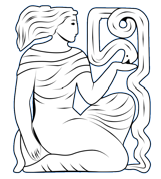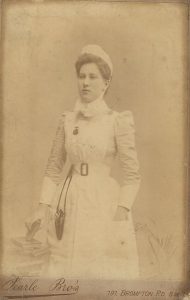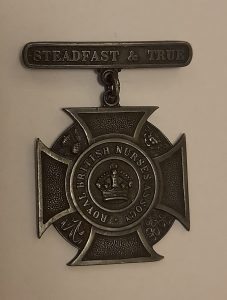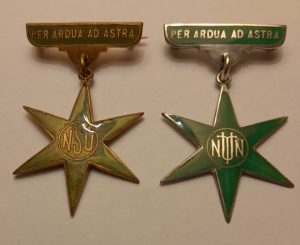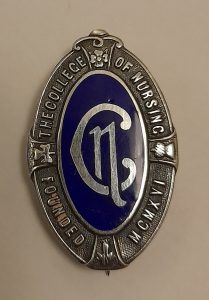By Stuart Wildman
The study of material culture or those ‘objects, things and artifacts’ associated with human activity originated in archeology and social anthropology but historians have become increasingly interested in these as source materials for investigating aspects of the past.[1] Historians contribute to the study of material culture by contextualizing objects in terms of time and place by linking them to other sources, for example documentary evidence.[2] In parallel to this academic interest in materiality is the public’s enthusiasm for collecting nursing badges and medals witnessed by the numbers for sale on many online sites. The large collection in the archives of the Royal College of Nursing (RCN) attests to the sheer number and variety of badges that were awarded by hospitals, schools of nursing and other organisations, mainly from the late nineteenth to the end of the twentieth century. The RCN website cites 3000 badges in the collection with 600 images available to view online.[3] Most badges were awarded for successfully completing training, but a small number were emblems of associations which promoted the social cohesion and professionalisation of nursing. Hospital nurses’ leagues, essentially alumni associations, are an example of the former whilst trade unions and campaign groups of the latter. The nurse’s uniform has been the subject of research and much discussion in the literature in terms of its origins and symbolism in the UK and elsewhere.[4] It has been identified as a means to set the nurse apart from other workers, to confer status on different grades of nurses but also a means to control nurses’ behaviour.[5] In contrast, the significance of the badges that nurses wore has received less attention. The few publications that exist mainly identify and catalogue badges with little analysis of their significance or context.[6] In contrast, Baroness McFarlane, in a very apposite foreword to the only noteworthy British study, described the badge as a ‘vignette through which the value system of the profession is portrayed’.[7] As such, this paper will use the badge as a way to identify and discuss some organizations which were concerned with the promotion of professional nursing and the ways in which the badge symbolized their aims and perceived status.
[Figure 1] Kate Noble
The thirty-year period leading up to the passing of the Nurses’ Registration Act (1919) was dominated by the work and opinions of one woman, Ethel Gordon Fenwick (also known as Bedford Fenwick).[8] A former matron of St Bartholomew’s Hospital, London, she was a tireless campaigner for nurse registration. Through her control of The Nursing Record (later changed to the British Journal of Nursing) she was able to publicise the cause for registration and to recruit trained nurses to a number of organisations which she created to advance the cause and to attack her opponents. She asserted that the Hospitals Association which operated a type of register wished to put nurses under the control of hospital authorities. In 1887 she founded the British Nurses Association, later the Royal British Nurses Association (RBNA) to campaign for the registration of nurses. The RBNA operated a list of trained nurses and issued certificates and badges to those deemed to be qualified, for a fee. Kate Noble can be seen wearing her badge (see Figure 1). She joined the RBNA in 1891, when she became a private nurse having trained and worked in poor law hospitals in London. For her, no doubt, membership and the badge itself offered validation and status in order to secure employment in a crowded field. The RBNA badge (Figure 2) is made of silver, featuring a cross and a crown as well as the national flora of the four nations; the rose, thistle, shamrock and leek. The suspension bar carries the motto ‘Steadfast and True’, indicating that the association saw itself as unwavering and determined in its purpose. Although it was still in existence in the twenty-first century, the RBNA had a much more minor role than expected in the ensuing struggle for registration.
[Figure 2] Badge of the Royal British Nurses Association. Photo by Stuart Wildman
Mrs. Gordon Fenwick was unceremoniously removed from the RBNA committee in 1894 but subsequently formed the Matrons Council of Great Britain and Ireland consisting of like-minded women from high-status hospitals who wished to further the cause of registration.[9] In 1902 she founded the Society for the State Registration of Nurses and in 1904 the two bodies, alongside the hospital leagues of St Bartholomew’s in London and the Leicester Infirmary, created the National Council of Nurses.[10] This represented British nurses at the International Council of Nurses (ICN), another body in which Gordon Fenwick was a founding member.[11] The National Council acted as an umbrella group attracting different organisations in the cause of registration. One such body was the Nurses Social Union (NSU). This originated in Somerset when nurses and lay women set up local groups to support isolated rural and small-town nurses in a social and professional way through lectures and exhibitions. The NSU was formally constituted in 1905 and began to spread across the country and by 1910 there were branches in London and other urban centres.[12] In 1913, it changed its name to the National Union of Trained Nurses (NUTN) to better reflect its work and its claim to represent all branches of nursing.[13] The badges of the NSU and NUTN can be seen in Figure 3. Apart from the lettering in the centre they are identical in design, consisting of a six-point star of enamel and metal (silver in the case of the NUTN badge) with a bar bearing the words Per Ardua Ad Astra (through adversity to the stars). Like that of the RBNA this is a stirring motto meant to signify the union’s aim to gain professional recognition and status. The NUTN became more involved in the movement for registration and following the passing of the Nurses Registration Act in 1919 officers of the union were appointed to the interim General Nursing Council for England and Wales. This probably represents the height of its success as it folded in 1923 due, according to Gordon Fenwick, to sabotage by the College of Nursing which actively target the membership of branches through ‘social influence and professional patronage’.[14]
[Figure 3, left] Badges of the Nurses Social Union and the National Union of Trained Nurses. [Figure 4, right] Badge of the College of Nursing. Photos by Stuart Wildman
The College of Nursing was established early in 1916 as a limited company.[15] It was proposed by Sarah Swift, matron-in-chief of the British Red Cross Society and the chairman, Arthur Stanley. This was to be similar to the medical colleges and would be responsible for training and maintaining a register of nurses. It soon gained traction, recruited many members and set up its own register. Members of the College received a modest sterling silver and enamel badge consisting of the entwined letters C and N centrally and the College name, the date of establishment on the surround along with the floral emblems of the four nations (Figure 4). The badge was updated in 1939, being topped by an imperial crown and the letter R added to the initials in the centre, when the College received permission to use the title Royal College of Nursing. A more elaborate badge was devised and the motto Tradimus Lampada (we pass on the torch), was added following the granting of a coat of arms in 1946.[16] This and the illustration of a lamp on the badge are an acknowledgement of both the past in terms of Florence Nightingale and the future of nursing with the RCN portraying itself as the leader of professional nursing.
Soon after its inception the College came into direct conflict with Gordon Fenwick who saw it as ‘a cabal of matrons, doctors and hospital governors, who reflected the views of employers rather than the nurses’.[17] At the end of World War One Parliament became more amenable to the idea of registration for nurses and rival bills were proposed, by competing factions. The government however, put forward its own bill which became law in December 1919. Initially, people from the various groups representing nurses were appointed to the fledgling General Nursing Council for England and Wales. However, following elections in 1923, Gordon Fenwick along with many of her allies were voted out and the College of Nursing came to dominate the proceedings of the Council.
Rather than give up, Gordon Fenwick continued with her opposition to the College and as she controlled the National Council of Nurses and thus representation at the ICN she was able to maintain a presence in nursing circles worldwide. This was boosted by an anonymous gift of £100,000 to establish the British College of Nursing in 1926.[18] Gordon Fenwick became the president for life and set it up as a rival to the College of Nursing, frustrating the latter’s ambitions to have exclusive control of professional nursing and to make international links. The silver badge of the British College, issued in 1928, (see Figure 5) features the head of Gordon Fenwick with the words knowledge, service, honour and charity, surrounded by a circle of oak leaves. The bar bears the title of the British College. This particular badge is engraved on the reverse to Isabel Davy, who qualified at St. Bartholomew’s during the time when Gordon Fenwick’s staunchest colleague, Isla Stewart, was matron. It is logical to surmise that someone who trained at the hospital in this period would have supported the British College and its president later in the century. This is the most personal of all the badges discussed here and could be seen as an egotistical statement by its president. Alternatively, it could be viewed as a way of honouring such a pivotal individual in the struggle for the professional recognition of nurses. The British College outlived both Mrs. Gordon Fenwick and her legacy of opposition to the College of Nursing and only withdrew from active participation in nursing in 1961. In 1963 the National Council of Nurses and the then Royal College of Nursing merged to form one professional body to represent nurses and bring an end to a long-term rivalry.[19]
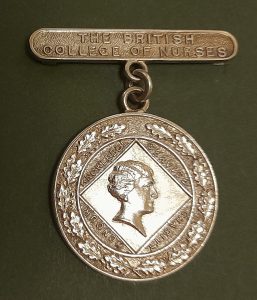
[Figure 5] Badge of the British College of Nursing. Photo by Stuart Wildman
Nursing badges, in all their forms, were and are a visible sign of status, education and experience. Badges and insignia were always worn by district nurses belonging to the Queen’s Institute for District Nursing as a way of being identified within the community. This point was made by some nurses during the period leading up to registration in order to distinguish trained nurses from others who wore the uniform, an argument criticized by the editor of the Nursing Times who felt nurses would be on a par with a cabman having to show his licence number to a passenger.[20] In the case of the organisations discussed here, badges could be seen as evidence of a nurse’s allegiance to a collective cause or movement. The badge of the NUTN and the British College was necessary to gain entry to meetings and functions but to what extent they were worn on the uniform is difficult to ascertain. As matrons often belonged to one camp or another, nurses were probably only allowed to wear badges that represented an organisation approved by the matron. Indeed, complaints were made that matrons who were members of the College of Nursing actively discouraged nurses joining the British College of Nursing and prevented them from attending its meetings.[21] Certainly, it is inconceivable to think that the profile of Mrs. Gordon Fenwick on a badge would have been tolerated in the wards of the London Hospital where her bitter rival and ardent opponent of registration, Eva Luckes, once ruled as matron. Looking at photographs from the early twentieth century, few nurses in uniform are depicted wearing badges but this becomes more common as time goes on. Certainly, by the end of the twentieth century most nurses working in general settings wore badges on their uniform, usually a training school badge, maybe a General Nursing Council badge and perhaps one from a trade union or professional organisation. This of course depended upon the rules for wearing uniform in individual hospitals and associations.
This paper has used the badge to illustrate the struggle for the professionalisation and registration of nursing. The symbols and mottoes on these badges were used to convey the importance and status of the individual organisations to nurses and to the general public. They gave nurses a sense of belonging to a professional group and as a part of a wider movement, which encompassed all four countries in the United Kingdom. In addition, individual nurses could use membership as a way of enhancing their own standing and of gaining employment. Only groups who saw themselves as professionals have been addressed in this paper, although a similar exercise could be undertaken to examine those trade unions which represented the rank-and-file nurse, particularly those in workhouses and mental health settings. Material culture does have something to offer in understanding the history of nursing. Other physical relics, such as clinical equipment or teaching aides may offer the historian another avenue for a better interpretation of the nursing past.[22]
Endnotes
[1] K. Harvey, ‘Introduction: Historians, Material Culture and Materiality’, in History and Material Culture: A Student’s Guide to Approaching Alternative Sources, ed. by K. Harvey (London: Taylor & Francis, 2017), 1.
[2] Ibid. 13.
[3] Royal College of Nursing (2021), Badges and medals [online]. Available at www.rcn.org.uk/library-exhibitions/special-collections-badges-and-medals [accessed 17 November 2023].
[4] J. Hallam, Nursing the Image: Media, Culture and Professional Identity (London: Routledge, 2000), 133-142; J. Brooks and A. M. Rafferty, ‘Dress and Distinction in Nursing, 1860–1939: A corporate (as well as corporeal) armour of probity and purity’, Women’s History Review, 16/1 (2007), 41–57; C. Bates, ‘Looking Closely: Visual and Material Approaches to the Nurse’s Uniform’, Nursing History Review 18 (2008), 167–88; C. Bates, ‘The Nurse’s Cap and its Rituals’, Dress 36/1 (2010), 21-40; C. Bates, A Cultural History of the Nurse’s Uniform (Quebec: Canadian Museum of Civilization, 2012).
[5] Brooks and Rafferty, ‘Dress and Distinction in Nursing’, 53.
[6] J. Meglaughlin, ‘Hospital Badges’, Nursing Times 76/3, 17 January 1980, 116-117; L. Dopson, ‘Hospital History in Miniature’, Nursing Times 78/25, 23 June 1982,1078-1079; J. Meglaughlin, British Nursing Badges, Volume 1: an Illustrated Handbook (London: Vade-Mecum Press, 1990); S. Callander-Grant, ‘Nurses’ Badges: Archaic Symbols or Icons of Nursing?’, International History of Nursing Journal 6/2 (2001), 71-74. Bates, Cultural History, gives some detail about Canadian badges, or pins as they are known there, but erroneously states that training schools in Britain only introduced badges in the 1960s.
[7] J. McFarlane, ‘Foreword’ in Meglaughlin, British Nursing Badges, 18.
[8] W. Hector, The Work of Mrs. Bedford Fenwick and the Rise of Professional Nursing (London: Royal College of Nursing, 1973), 1-7.
[9] A. M. Rafferty, The Politics of Nursing Knowledge (London: Routledge, 1996), 64.
[10] B. Abel-Smith, A History of the Nursing Profession (London, Heinemann, 1960), 76.
[11] N. J. Tomes and G. Boschma, ‘Above All Other Things – Unity’, in Nurses of All Nations: A History of the International Council of Nurses, 1899-1999, ed. by B. L. Brush and J. E. Lynaugh (Philadelphia: Lippincott, 1999), 1-38.
[12] E. Eden, ‘The Nurses Social Union and its Objects’, Nursing Times 1/24, 24 October 1905, 12; Anonymous, ‘Nurses Social Union’, Nursing Times 6/261, 30 April 1910, 373.
[13] Anonymous, ‘Nurses Social Union’, British Journal of Nursing 50/1309, 21 April 1913, 1; Anonymous, ‘National Union of Trained Nurses’, Nursing Times 9/439, 27 September 1913, 1068.
[14] Anonymous, ‘National Union of Trained Nurses’, British Journal of Nursing 71/1841, 14 July 1923, 29.
[15] Abel-Smith, Nursing Profession, 89.
[16] G. Bowman, The Lamp and the Book: The Story of the RCN: 1916-1966 (London: Queen Anne Press, 1967), 94-97.
[17] S. McGann, A. Crowther and R. Dougall, A History of the Royal College of Nursing, 1916-90: A Voice for Nurses (Manchester: Manchester University Press, 2009), 18.
[18] Anonymous, ‘The British College of Nursing’, Nursing Times 22/1099, 26 May 1926, 470.
[19] McGann et al, History of the Royal College of Nursing, 188-191.
[20] Anonymous, ‘One Who Always Wears the Badge: Letter to the Editor’, Nursing Record 11/276, 13 July 1893, 11; Anonymous, ‘Badges: Letter to the Editor’, Nursing Times 1/32, 9 December 1905, 642; Anonymous, ‘Badges for Nurses’, Nursing Times 1/27, 4 November 1905, 540.
[21] Anonymous, ‘Nursing Echoes’, British Journal of Nursing 74/1901, [no date] December 1926, 267.
[22] See for instance C. Buse, D. Martin and S. Nettleton ‘Conceptualising ‘materialities of care’: making visible mundane material culture in health and social care contexts’, Sociology of Health & Illness 40/2 (2018), 243-255.
